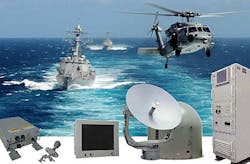Navy chooses AN/SRQ-4 ship-to-helicopter datalink radios from L3 for situational awareness
PATUXENT RIVER NAS, Md., 26 June 2013. U.S. Navy helicopter avionics experts needed a digital data link to enable helicopters to share sensor information in real time with Navy and Coast Guard surface ships. They found their solution from L3 Communications-West in Salt Lake City.
Officials of the Naval Air Systems Command at Patuxent River Naval Air Station, Md., announced a $6.7 million contract modification Tuesday to L3 to provide four Common Data Link Hawklink AN/SRQ-4 radio terminal sets for the Navy and one for the U.S. Coast Guard.
The AN/SRQ-4 is the shipboard element of a situational awareness system that links the MH-60R helicopter with surface warships in the area. It provides command and control (C2), sensor data transfer, data link operation, and built-in-test.
The system provides real-time use of aircraft sensors to extend situational awareness over the horizon by enabling surveillance helicopters to data-link radar, video, networking, and acoustic data to Navy Arleigh Burke-class destroyers, Ticonderoga-class cruisers, and Perry-class frigates. Its control systems run on modern open-systems architectures, L3 officials say.
The AN/SRQ-4 supports anti-submarine warfare (ASW) and anti-ship surveillance and targeting (ASST) missions; receives and distributes full-motion video; is IP-enabled and built to work with future network-centric applications; is compatible with the SAU7000 digital messaging interface; and has ruggedized construction and modules that are qualified to Navy shock and environmental standards.
The AN/SRQ-4 also has expanded CDL frequency range to support MH-60R helicopter operations; makes the most of link performance by auto-switching between open-loop pointing and closed-loop tracking, depending on the range between the helicopter and the ship; has a range of 100 nautical miles to the AN/ARQ-50 airborne terminal; and has built-in test.
The system is interoperable with the CDL family of airborne terminals not only on the MH-60R, but also for the Fire Scout unmanned aerial vehicle (UAV), the P-3 Orion surveillance turboprop aircraft, and the P-8 Poseidon maritime patrol jet.
It has a touch-screen graphic user interface for control and status; and has a growth path to dual-link operation, L3 officials say. The system is interoperable with the Navy SQQ-89 anti-submarine warfare system and shipboard Navigation Sensor System Interfaces (NAVSSI). It is software-configurable for Common Data Link (CDL) waveforms.
For this contract modification L3 will do the work in Salt Lake City; Atlanta; Mountain View, Calif.; Exeter, N.H.; and other sites in the U.S. and Canada, and should be finished by May 2015.
For more information contact L3 Communications-West online at www2.l-3com.com/csw, or Naval Air Systems Command at www.navair.navy.mil.
